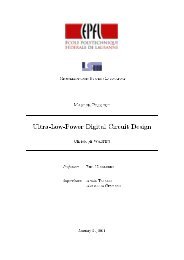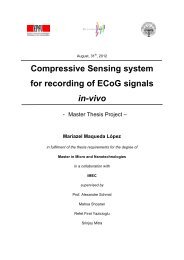"Linear Equation Solver using CMOS Technology" - Microelectronic ...
"Linear Equation Solver using CMOS Technology" - Microelectronic ...
"Linear Equation Solver using CMOS Technology" - Microelectronic ...
Create successful ePaper yourself
Turn your PDF publications into a flip-book with our unique Google optimized e-Paper software.
1 IntroductionIn cryptography, encryption is the process of transforming information, plaintext, <strong>using</strong> a specificalgorithm, cipher, to make in unreadable to anyone except those possessing special knowledge,usually referred to as a key [1]. A reverse process, decryption, has to be applied in order to make theencrypted information, ciphertext, readable again. The reliability of a particular Encryption/Decryptionalgorithm, its algorithmic strength, is defined as its resistance to the mathematical attacks, the processof mathematically cracking the algorithm. It is important to note that even if a cipher cannot becracked mathematically, such as Advanced Encryption Standard (AES), it may still be cracked via sidechannel attacks. These cracking methods are based on information gained from the physicalimplementation of such algorithms, rather than brute force or theoretical weakness in the ciphers(cryptanalysis). For example, timing information, power consumption, electromagnetic leaks or evensound can provide an extra source of information which can be exploited to break the system[2].However, these attacks require some technical knowledge regarding the internal operation of thehardware on which the cipher is implemented.Encryption/Decryption process is commonly used in various applications in order to protectinformation. For instance, militaries and governments rely on this process to facilitate secretcommunication; many kinds of civilian systems (internet, Bluetooth, wireless systems, ATMs, etc...)utilize this process to ensure privacy via the protection of the data at rest, as well as the data in transitover the networks [1]. However, successfully ensuring the data security may be a challengingproblem.For instance, though initially kept secret, A5/1 Cipher, which is the standard encryption algorithm forGSM in Europe and the US, was obtained by reverse engineering.A5/1 cipher basically produces a 114-bit sequence of keystream which is XORed with line bits prior tomodulation, for each burst in a GSM transmission. It is initialized <strong>using</strong> a 64-bit key together with apublicly-known 22-bit frame number [3]. The cipher utilizes a combination of three linear feedbackshift registers (LFSRs) with irregular clocking, specified in Figure 1.Figure 1. The Specified Shift Registers for A5/1 [3]8















